#reviews
Text
Rebecca Roque’s “Till Human Voices Wake Us”
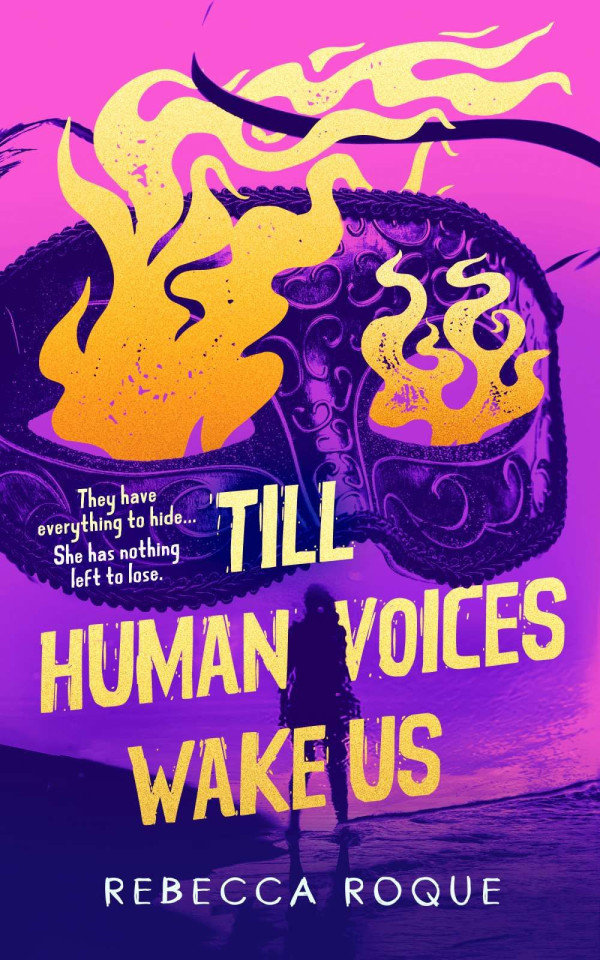
I'm touring my new, nationally bestselling novel The Bezzle! Catch me in TOMORROW (Apr 17) in CHICAGO, then Torino (Apr 21) Marin County (Apr 27), Winnipeg (May 2), Calgary (May 3), Vancouver (May 4), and beyond!

"Till Human Voices Wake Us" is Rebecca Roque's debut novel: it's a superb teen thriller, intricately plotted and brilliantly executed, packed with imaginative technological turns that amp up the tension and suspense:
https://www.blackstonepublishing.com/till-human-voices-wake-us-gn3a.html#541=2790108
Modern technology presents a serious problem for a thriller writer. Once characters can call or text one another, a whole portfolio of suspense-building gimmicks – like the high-speed race across town – just stop working. For years, thriller writers contrived implausible – but narratively convenient – ways to go on using these tropes. Think of the shopworn "damn, my phone is out of battery/range just when I need it the most":
https://www.youtube.com/watch?v=XIZVcRccCx0
When that fails, often writers just lean into the "idiot plot" – a plot that only works because the characters are acting like idiots:
https://en.wikipedia.org/wiki/Idiot_plot
But even as technology was sawing a hole in the suspense writer's bag of tricks, shrewd suspense writers were cooking up a whole new menu of clever ways to build suspense in ways that turn on the limitations and capabilities of technology. One pioneer of this was Iain M Banks (RIP), whose 2003 novel Dead Air was jammed with wildly ingenious ways to use cellphones to raise the stakes and heighten the tension:
https://web.archive.org/web/20030302073539/http://www.wired.com/wired/archive/11.03/play.html?pg=8
This is "techno-realism" at its best. It's my favorite mode of storytelling, the thing I lean into with my Little Brother and Martin Hench books – stories that treat the things that technology can and can't do as features, not bugs. Rather than having the hacker "crack the mainframe's cryptography in 20 minutes when everyone swears it can't be done in less than 25," the techno-realist introduces something gnarlier, like a supply-chain attack that inserts a back-door, or a hardware keylogger, or a Remote Access Trojan.
Back to Roque's debut novel: it's a teen murder mystery told in the most technorealist way. Cia's best friend Alice has been trying to find her missing boyfriend for months, and in her investigation, she's discovered their small town's dark secret – a string of disappearances, deaths and fires that are the hidden backdrop to the town's out-of-control addiction problem.
Alice has something to tell Cia, something about the fire that orphaned her and cost her one leg when she was only five years old, but Cia refuses to hear it. Instead, they have a blazing fight, and part ways. It's the last time Cia and Alice ever see each other: that night, Alice kills herself.
Or does she? Cia is convinced that Alice has been murdered, and that her murder is connected to the drug- and death-epidemic that's ravaging their town. As Cia and her friends seek to discover the town's secret – and the identity of Alice's killer – we're dragged into an intense, gripping murder mystery/conspiracy story that is full of surprises and reversals, each more fiendishly clever than the last.
But as good as the storytelling, the characterization and the mystery are, Roque's clever technological gambits are even better. This book is a master-class in how a murder mystery can work in the age of social media and ubiquitous mobile devices. It's the first volume in a trilogy and it ends on a hell of a cliff-hanger, too.

If you'd like an essay-formatted version of this post to read or share, here's a link to it on pluralistic.net, my surveillance-free, ad-free, tracker-free blog:
https://pluralistic.net/2024/04/16/dead-air/#technorealism
72 notes
·
View notes
Text









Hi i want to talk about my all time favorite camera 📸
pls ignore all my grammar mistakes, i’m not professional reviewer 😂 i just wanna talk about this camera.
This is the Sony RX1Rii, this is the third and “most recent” version of this camera. i put “most recent” in quotes because this camera is almost 10 years old. don’t like the old age fool you because this camera can keep up with the newest cameras in its niche.
This little point and shoot sports a 42mp full frame sensor. YES, F U L L F R A M E!! This tiny camera is actually smaller than all the x100 series (minus the lens on it). The camera has an incredibly sharp Zeiss Sonnar 35mm f2 glued to. This camera has 399 af points, with eye AF. The camera is incredibly fast and accurate!! the camera is pretty much a tiny packaged Sony A7Rii!
One of my favorite features of this camera is the pop-up EVF! This is a feature that was added to only this version of the camera and it’s a feature that i wish sony continued to incorporate into some of their other smaller cameras like the A7c or a6k series!

The camera does shoot video up to 1080 120fps, but does not have picture profiles such has S-log or HLG. This was a camera made strictly for photos, which is probably for the best because the battery life on this camera is terrible, any kind of prolong video shooting would absolutely burn through these batteries in minutes.
That brings me to my next point, my cons. There’s not many but i figured i’d point them out anyways for those who are interested in this camera. these aren’t make it or break it cons, these are just issues that hinder it from being the greatest camera ever released (IMO)
1) battery life, i believe it’s rated for like 220 shots. Ive definitely gotten it to last twice than that. That tiny body processing all that data on some of the tiniest batteries makes sense why it’s so bad. Luckily batteries are cheap and like i said they’re tiny, so they’re pretty easy to carry around!
2) no picture profiles in video. i know i touched on it briefly up above and this camera is mainly a photo camera AAAAAND hybrid cameras were just beginning to grow in popularity around the time this camera came out but it would’ve been amazing to have s-log in this camera for little snippets here and there. i know at the time IG and other photo sharing apps were mainly photo sharing apps, and a camera that was built strictly for photo has no business having usable picture profiles in video.
3) no crop mode in RAW. this one is weird to me because i know the A7Rii has an APS-C mode where you can shoot RAW photos with an inbody crop and there’s times that i’d love to shoot something at 50mm (35mm + sony’s 1.5x aps-c crop). there is a digital zoom option but that’s for jpg only.
4) PRICE!!!! why the fuck is this camera still being sold for $3200??!! this is a 10 year old camera with outdated tech. i bought mine used for $1900 (which is about the price of the fuji x100V at the time of purchase) and i still think that’s a little too much.
that’s really about it aside from minor complaints of not having tele/ wide converters. i’m also sure all of those cons stem from the small battery. I’d love to see all of these corrected in a Mk3 one day, but as of a couple weeks ago sony just discontinued the Rx1rii’s production. I’m being a little hopeful but maybe that means we’re getting a successor, i doubt it but a boy can dream.
I don’t really do reviews or anything but this camera has had my heart for the past 9 months so i had to show it off/ talk about it. this to me in the perfect everyday camera. it never leaves my side and comes with me to any and every trip! Im always blown away by the photos i create with this little camera and i know whenever a mk3 comes out im going to hop on the chance to buy on immediately!
#Sony#Rx1rii#sony rx1#fujifilm#fujifilm x100v#fuji x100v#x100v#fuji x100vi#x100vi#lookslikefilm#original photographers#photographers on tumblr#new tumblr#artists on tumblr#photogram#35mm#photography#film#point and shoot#point and click#reviews#tumblr
27 notes
·
View notes
Text


Review of a butterfly farm… 🦋
#reviews#customer service#memes#meme#funny memes#butterflies#butterfly#the customer is always wrong#butterfly farm#Karen memes#top post
134K notes
·
View notes
Text



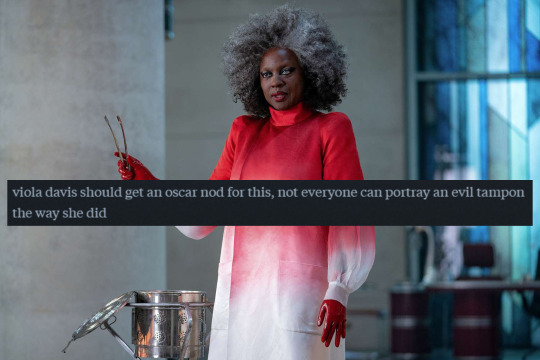

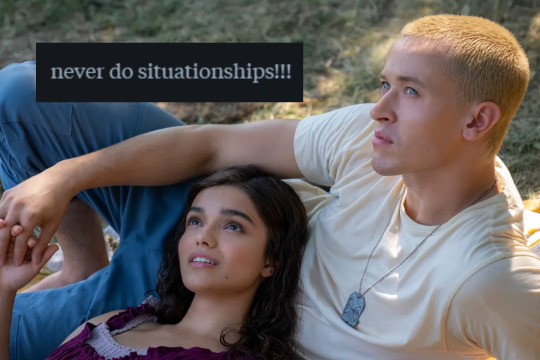

More BOSAS Reviews Pt 3 ⭐
#The Ballad of Songbirds and Snakes#TBOSAS#BOSAS#coriolanus snow#Lucy Gray Baird#volumnia gaul#Review#Funny#The Hunger Games#president snow#hunger games#thg#Funny Reviews#Reviews
4K notes
·
View notes
Text
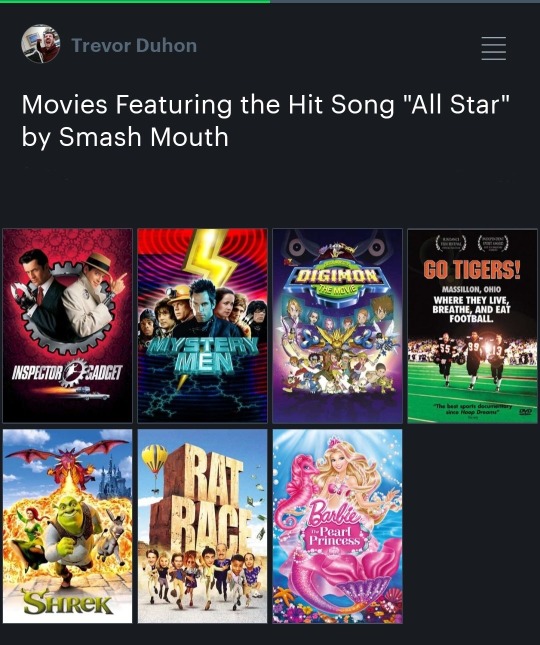
#letterboxd#movie#movie review#movie reviews#movies#movie recommendation#movie recommendations#review#reviews#steve harwell#smash mouth#all star#barbie the pearl princess#rat race#shrek#go tigers#digimon#digimon the movie#mystery men#inspector gadget
6K notes
·
View notes
Text
Letterboxd reviews for Saw X
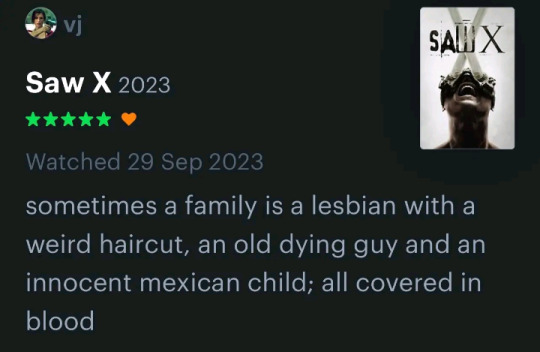


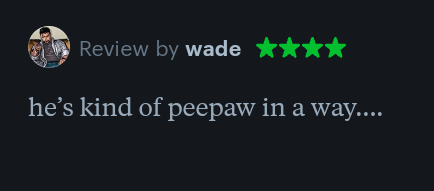
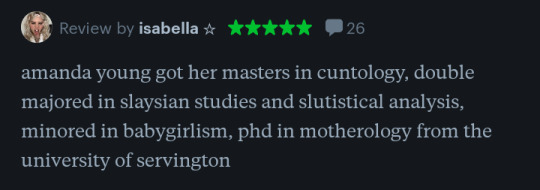





#saw shitpost#saw franchise#saw movies#saw x#saw x spoilers#saw x (2023)#amanda young#john kramer#jigsaw#saw 2004#saw#letterboxd#reviews#funnyshit#what the fuvk#Bruh they brought back Amanda after years and made her look like fucking Spock
3K notes
·
View notes
Note
How do you cope with seeing negative reviews about your work? I've always dreamed of publishing a novel, but I'm very afraid of seeing criticism online if I did.
You cope. You might cope by not reading them, or by not going online, or by deciding that different people have different tastes and it's a good thing that not everyone likes the same things because otherwise there would be no room in the world for those of us who make things that aren't intended for everyone. But however you do it, you cope.
2K notes
·
View notes
Text
Kelly and Zach Weinersmith’s “A City On Mars”

In A City On Mars, biologist Kelly Weinersmith and cartoonist Zach Weinersmith set out to investigate the governance challenges of the impending space settlements they were told were just over the horizon. Instead, they discovered that humans aren't going to be settling space for a very long time, and so they wrote a book about that instead:
https://www.acityonmars.com/
The Weinersmiths make the (convincing) case that ever aspect of space settlement is vastly beyond our current or reasonably foreseeable technical capability. What's more, every argument in favor of pursuing space settlement is errant nonsense. And finally: all the energy we are putting into space settlement actually holds back real space science, which offers numerous benefits to our species and planet (and is just darned cool).
Every place we might settle in space – giant rotating rings, the Moon, Mars – is vastly more hostile than Earth. Not just more hostile than Earth as it stands today – the most degraded, climate-wracked, nuke-blasted Earth you can imagine is a paradise of habitability compared to anything else. Mars is covered in poison and the sky disappears under planet-sized storms that go on and on. The Moon is covered in black-lung-causing, razor-sharp, electrostatically charged dust. Everything is radioactive. There's virtually no water. There are temperature swings of hundreds of degrees every couple of hours or weeks. You're completely out of range of resupply, emergency help, or, you know, air.
There's Helium 3 on the Moon, but not much of it, and there is no universe in which is it cheaper to mine for Helium 3 on the Moon than it is to mine for it on Earth. That's generally true of anything we might bring back from space, up to and including continent-sized chunks of asteroid platinum.
Going to space doesn't end war. The countries that have gone to space are among the most militarily belligerent in human history. The people who've been to space have come back perfectly prepared to wage war.
Going to space won't save us from the climate emergency. The unimaginably vast trove of material and the energy and advanced technology needed to lift it off Earth and get it to Mars is orders of magnitude more material and energy than we would need to resolve the actual climate emergency here.
We aren't anywhere near being a "multiplanetary species." The number of humans you need in a colony to establish a new population is hard to estimate, but it's very large. Larger than we can foreseeably establish on the Moon, on Mars, or on a space-station. But even if we could establish such a colony, there's little evidence that it could sustain itself – not only are we a very, very long way off from such a population being able to satisfy its material needs off-planet, but we have little reason to believe that children could gestate, be born, and grow to adulthood off-planet.
To top it all off, there's space law – the inciting subject matter for this excellent book. There's a lot of space law, and while there are some areas of ambiguity, the claims of would-be space entrepreneurs about how their plans are permissible under the settled parts of space law don't hold up. But those claims are robust compared to claims that space law will simply sublimate into its constituent molecules when exposed to the reality of space travel, space settlement, and (most importantly) space extraction.
Space law doesn't exist in a vacuum (rimshot). It is parallel to – and shares history with – laws regarding Antarctica, the ocean's surface, and the ocean's floor. These laws relate to territories that are both vastly easier to access and far more densely populated by valuable natural resources. The fact that they remain operative in the face of economic imperatives demands that space settlement advocates offer a more convincing account than "money talks, bullshit walks, space law is toast the minute we land on a $14 quadrillion platinum asteroid."
The Weinersmiths have such an account in defense of space law: namely, that space law, and its terrestrial analogs, constitute a durable means of resolving conflicts that would otherwise give rise to outcomes that are far worse for science, entrepreneurship, human thriving or nation-building than the impediments these laws represent.
What's more, space law is enforceable. Not only would any space settlement be terribly, urgently dependent on support from Earth for the long-foreseeable future, but every asteroid miner, Lunar He3 exporter and Martian potato-farmer hoping to monetize their products would have an enforcement nexus with a terrestrial nation and thus the courts of that nation.
But the Weinersmiths aren't anti-space. They aren't even anti-space-settlement. Rather, they argue that the path to space-based scientific breakthroughs, exploration of our solar system, and a deeper understanding of our moral standing in a vast universe cannot start with space settlements.
Landing people on the Moon or Mars any time soon is a stunt – a very, very expensive stunt. These boondoggles aren't just terribly risky (though they are – people who attempt space settlement are very likely to die horribly and after not very long), they come with price-tags that would pay for meaningful space science. For the price of a crewed return trip to Mars, you could put multiple robots onto every significant object in our solar system, and pilot an appreciable fleet of these robot explorers back to Earth with samples.
For the cost of a tiny, fraught, lethal Moon-base, we could create hundreds of experiments in creating efficient, long-term, closed biospheres for human life.
That's the crux of the Weinersmiths' argument: if you want to establish space settlements, you need to do a bunch of other stuff first, like figure out life-support, learn more about our celestial neighbors, and vastly improve our robotics. If you want to create stable space-settlements, you'll need to create robust governance systems – space law that you can count on, rather than space law that you plan on shoving out the airlock. If you want humans to reproduce in space – a necessary precondition for a space settlement that lasts more than a single human lifespan – then we need to do things like breed multiple generations of rodents and other animals, on space stations.
Space is amazing. Space science is amazing. Crewed scientific space missions are amazing. But space isn't amazing because it offers a "Plan B" for an Earth that is imperiled by humanity's recklessness. Space isn't amazing because it offers unparalleled material wealth, or unlimited energy, or a chance to live without laws or governance. It's not amazing because it will end war by mixing the sensawunda of the "Pale Blue Dot" with the lebensraum of an infinite universe.
A science-driven approach to space offers many dividends for our species and planet. If we can figure out how to extract resources as dispersed as Lunar He3 or asteroid ice, we'll have solved problems like extracting tons of gold from the ocean or conflict minerals from landfill sites, these being several orders of magnitude more resource-dense than space. If we can figure out how to create self-sustaining terraria for large human populations in the radiation-, heat- and cold-blasted environs of space, we will have learned vital things about our own planet's ecosystems. If we can build the robots that are necessary for supporting a space society, we will have learned how to build robots that take up the most dangerous and unpleasant tasks that human workers perform on Earth today.
In other words, it's not just that we should solve Earth's problems before attempting space settlement – it's that we can't settle space until we figure out the solutions to Earth's problems. Earth's problems are far simpler than the problems of space settlement.
As I read the Weinersmiths' critique of space settlement, I kept thinking of the pointless AI debates I keep getting dragged into. Arguments for space settlement that turn on existential risks (like humanity being wiped out by comets, sunspots, nuclear armageddon or climate collapse) sound an awful lot like the arguments about "AI safety" – the "risk" that the plausible sentence generator is on the verge of becoming conscious and turning us all into paperclips.
Both arguments are part of a sales-pitch for investment in commercial ventures that have no plausible commercial case, but whose backers are hoping to get rich anyway, and are (often) sincerely besotted with their own fantasies:
https://locusmag.com/2023/12/commentary-cory-doctorow-what-kind-of-bubble-is-ai/
Both AI and space settlement pass over the real risks, such as the climate consequences of their deployment, or the labor conditions associated with their production. After all, when you're heading off existential risk, you don't stop to worry about some carbon emissions or wage theft.
And critically, both ignore the useful (but resolutely noncommercial) ways that AI or space science can benefit our species. AI radiology analysis might be useful as an adjunct to human radiological analysis, but that is more expensive, not less. Space science might help us learn to use our materials more efficiently on Earth, and that will come long before anyone makes rendezvous with a $14 quadrillion platinum asteroid.
There are beneficial uses for LLMs. When the Human Rights Data Analysis Group uses an LLM to help the Innocence Project New Orleans extract and categorize officer information from wrongful conviction records, they are doing something valuable and important:
https://hrdag.org/tech-notes/large-language-models-IPNO.html
It's socially important work, a form of automation that is an unalloyed good, but you won't hear about it from LLM advocates. No one is gonna get rich on improving the efficiency of overturning wrongful convictions with natural language processing. You can't inflate a stock bubble with the Innocence Project.
By the same token, learning about improving gestational health by breeding multigenerational mouse families in geosynchronous orbit is no way to get a billionaire tech baron to commit $250 billion to space science. But that's not an argument against emphasizing real science that really benefits our whole species. It's an argument for taking away capital allocation authority from tech billionaires.
I'm a science fiction writer. I love stories about space. But I can distinguish fantasy from reality and thought experiments from suggestions. Kim Stanley Robinson's 2015 novel Aurora – about failed space settlement – is every bit as fascinating and inspirational as "golden age" sf:
https://memex.craphound.com/2015/11/02/kim-stanley-robinsons-aurora-space-is-bigger-than-you-think/
But still, it inspired howls of outrage from would-be space colonists. So much so that Stan wrote a brilliant essay explaining what we were all missing about space settlement, which I published:
https://boingboing.net/2015/11/16/our-generation-ships-will-sink.html
With City on Mars, the Weinersmiths aren't making the case for giving up on space, nor are they trying to strip space of its romance and excitement. They're trying to get us to focus on the beneficial, exciting, serious space science we can do right now, not just because it's attainable and useful – but because it is a necessary precondition for any actual space settlement in the distant future.

If you'd like an essay-formatted version of this post to read or share, here's a link to it on pluralistic.net, my surveillance-free, ad-free, tracker-free blog:
https://pluralistic.net/2024/01/09/astrobezzle/#send-robots-instead
#pluralistic#books#reviews#space#bezzles#mars#spacex#robots#science#space science#space travel#space settlement#space colonization
1K notes
·
View notes
Text
Good Stuff: Bluey's The Sign

Bluey is still great and I don't need to go into why again. What's most important is that even in such short time of knowing this cartoon, you can see the growth of it all. Joe and the crew share how the world of the Heeler family gets to learn, adapt, and grow without rapidly warping the status quo. You go through and see how everyone is able to work through rough and weird times with sincere maturity. Season 3's Finale is where this all comes to a head and it's as beautiful as I expected, MORESO.

Brandi got to be happy would've been enough for me
The Sign deals with the idea of hard ideas. Those hard ideas that aren't inherently about change, but issues that when faced with initially, it feels like a bad ending. A bad ending which can't be easily fixed and you don't know where to go from there, and it hurts. It hurts when hard ideas swoop in, ruins your mood, festers your mind, and leaves you aimless. Bluey shows that it happens, this is the rare time where a ton of crap hits the fan in one day and it's not something Chili or Bandit or any adult can fix right away. I've never experienced this, but I felt the pain Bluey, Bingo, Frisky, and Chili went through where they're bargaining, burying, and avoiding confronting a potential reality they didn't want. This is where the real hero of the special comes in...

Haven't said before, but Calypso is a masterful teacher
The parable of the farmer works as an incredible seedling thought for Bluey when she reveals her moving. It's not a story I ever heard, but known the message all too well. The message of not just accepting bad things that happen to you, but know that it'll never be the end of the world because of them. Don't think of it as deep, but a natural motif to grow with. This is where a debacle regarding the episode churns with me. It can seem like a cop-out that every character gets what they wanted by the end, as I said before the cartoon can be more idealistic than what our real life allows. Then again, the true beauty of Bluey I believe has always been if it's possible, the family will find a way and do it responsibly.
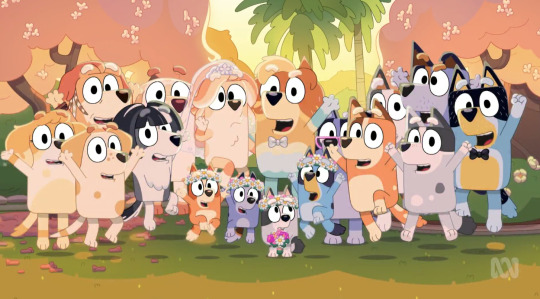
If happiness can be achieved, they'll know how to get it
Beyond all this, the special is great. They waste no minute here in art and storytelling, and as said before, it's like Smash Bros Ultimate where everything is here. There are great callbacks to episodes you probably wouldn't have thought about, on top of getting to see the whole Heeler family on Chili and Bandit's sides like that blew my mind. Plus I love seeing weddings, dude, like I wish I was there with them. The feels are tsunami-ous like it's unfair to say this is the all-time best episode of the show, but darn if it wouldn't be earned.
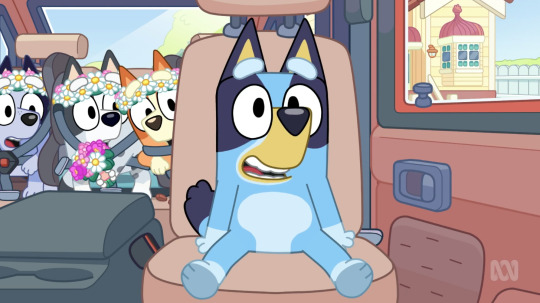
When else will I see the epicness of riding shotgun?
But to conclude, it's been said that after this the Ludo crew will take a indefinite hiatus from Bluey the series, especially when they have a new project underway. And honestly? I'm more than satisfied. The show could've ended here and I would've been somewhat at peace with them giving us this beautiful episode. I of course didn't get into this series since its beginning, but I came around the right time to enjoy it myself, to see others recognize its greatness, and to finally make it here. It's great to know this was only another chapter in the book, and I'll see to be around when it gets to come back. As for The Sign? What else is there to say?

It was Beautiful. Cheers to the crew for everything.
217 notes
·
View notes
Text
'I'm in Love with the Villainess' Anime - Episode 1 Review
An astounding and hilarious first outing for the series with the power to revolutionize Yuri
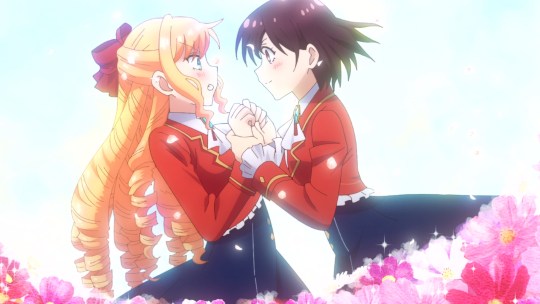
We are finally here, the long-awaited and much anticipated first episode of Platinum Vision’s I’m in Love with the Villainess anime aired on Tokyo MX and is streaming everywhere outside of Asia with a plethora of dubbing options, including English, on day one on Crunchyroll.
The first outing covers most of the events of the light novel’s first chapter, or the first three chapters of the manga, at a rapid but steady and not overwhelming pace. At this rate, the anime should be able to cover much of the series’ first arc, or the first two out of five books, in a single cour. Perhaps a bit less, depending on which of the story’s various adventures it elects to include. This is an exciting possibility, to be sure, as the story is a character-driven, socially mindful, and expertly written and, despite its fantasy setting, an exceptionally relevant tale of romance, socio-economic inequality, and of course, queerness.
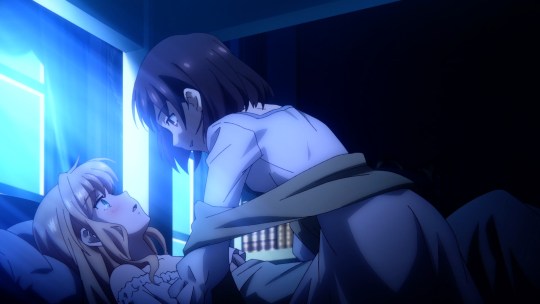
While the first arc of Villainess is a triumph, it would be a shame not to see at least some of the developments from the extra chapters that lead into the second story, like (spoilers for the end of volume 2) Rae and Claire’s wedding and their adopted twin daughters May and Aleah. If we are lucky, perhaps they will appear in the final episode or, dare to dream, a second season (end of spoilers).
Now, onto the show itself. For those who, for whatever reason, have not read Inori’s masterpiece, I’m in Love with the Villainess follows Rae Taylor. A salary worker who dies and is reincarnated as the protagonist of her favorite otome game, Revolution. However, Rae has no interest in any of the game world’s three eligible royal bachelors and has eyes only for the game villainess Claire François. Armed with exceptionally magical ability, Rae sets out determined to secure a happy ending for her beloved Claire against the coming revolution and perhaps win her heart in the process.
Now, the opening of I’m in Love with the Villainess is the series' weakest moment in all mediums, which, considering episode one’s outstanding quality, only highlights just how superb the Yuri masterpiece is as a whole. Even with its need to establish the setting, characters, and premise of the series, the premiere managed to be an excellent introduction and set the bar high with lots of laughs, entertainment, and service between our two leads.

I watched the Japanese audio, and Yu Serizawa and Karin Nanami are fantastic in these roles, with Serizawa playing up Rae’s teasing adoration and borderline masochism at full blast, and Nanami explicitly giving voice to Claire’s arrogance and frustration. She even manages to deliver a perfect Ojou-style laugh to seal the character’s elite status and lean into the show’s use of otome tropes. And having the leads sing the excellent opening and ending themes is just icing on the cake.
Speaking of tropes, while Ironi’s original work is a genre-defying masterpiece that broke the Yuri mold, it is never afraid to play with the genre’s iconography and its otome game setting. Every other scene had another allusion, including to the book’s cover. As always, I am likely overeager to see connections, however intentional they may be, but the academy’s halls harken to otome staples, the bells and strings of the first scene's soundtrack conjured blistering memories of Strawberry Panic (perhaps a sacrilegious comparison to make but I digress), and even an areal shot of the campus was another check mark on my “Scenic Yuri” theory.
Now, as mentioned, I’m in Love with the Villainess has to establish the groundwork here, and narratively, these are the weakest moments, often direct exposition, with a few exceptions like Rae’s conversation with her roommate Mash about maintaining Claire’s attention. The narration is at least accompanied by relevant and creative, if perhaps limited, animation. But to their credit, these moments are succinct, existing only as long as they have to in order to provide the necessary information and get out of the way for what matters most: the characters.
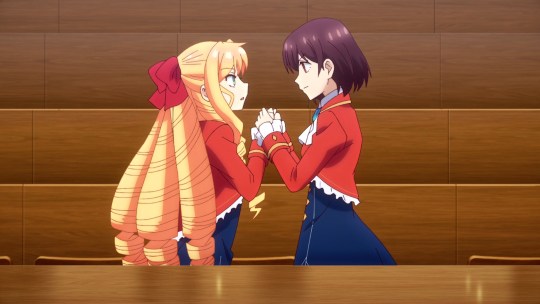
Rae and Claire are front and center from the very get-go, and there is little time wasted in showcasing Rae’s intense bottom energy or establishing Claire’s elitism and bewildered anger towards Rae’s excitement in the face of Claire’s carefully calculated cruelty. It is a montage of silly and fun competitions between the two that had me laughing and smiling all the way through, as the Yuri was present in full force, and gives glimpses at the mutual obsession the women have for each other that will soon blossom into a wonderful romance.
These early story beats have a light tone and focus on the bullying, teasing, and rivalry between Rae and Claire, a dynamic that previously and understandably made a subset of readers somewhat uncomfortable. However, assuming the anime unfolds in a similar manner to the manga and light novels, the narrative will explore meatier, heavier subject matter and a far deeper lesbian romance, all without losing its sense of fun and adventure. The next episode or two will be incredibly telling - as the source material is perhaps the most profound and forthright depictions of LGBTQ identity in Yuri, and that all starts with a pivotal conversation that, if it is included, will be coming up shortly.
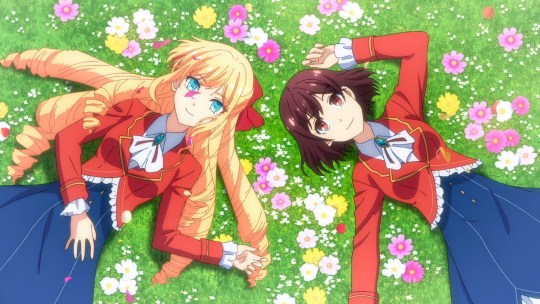
Overall, I am incredibly excited for this series. The first episode is everything I had hoped for out of an adaptation of one of my favorite works of all time, save the animation, which is average at best. While there is a lot more to see, and we will have to wait to know if I’m in Love with the Villainess lives up to its incredible potential and source material, I am extremely hopeful. We have one of the funniest, most thoughtful, and queerest works of Yuri transformed into a stunning anime project unlike anything that has come before and offers the chance at not just a new Yuri “gateway” but to continue the work of its source material in revolutionizing the genre.
Ratings:
Story – 8
Characters – 10
Art – 5
LGBTQ – We shall see…
Sexual Content – 3
Final – 8
I'm in Love with the Villainess is streaming on Crunchyroll with English sub/dub.
Review made possible by Avery Riehl and the rest of the YuriMother Patrons. Support YuriMother on Patreon for early access, exclusive article, and more: patreon.com/yurimother
#yuri#Reviews#girls love#lgbt#anime#i'm in love with the villainess#ILTV#lgbtq#gay#gl#queer#lesbian#manga#yuri anime#gl anime
621 notes
·
View notes
Text
Just saw D&D: Honor Among Thieves, some thoughts
- Yes, perfect, this is exactly what I wanted from my D&D movie, complete ridiculousness taken 100% seriously. Perfect. No notes.
- Watching Chris Pine be a charming little cringe-fail bard is amazing.
- WHAT SANE MAN WOULD LEAVE A WOMAN LIKE HOLGA?! SHE’S LITERALLY PERFECT! THAT SOUNDS LIKE A YOU PROBLEM BUCKO! SHE’S LITERALLY FLAWLESS!
- Head: Sofina evil. Heart: Hrrgh, hot evil lady step on me.
- Xenk Yendar is the purest force of good in the world and must be protected at all costs. Not that he needs it, but I’m sure he would graciously accept the sentiment.
- Simon hit his insecurities right in the face. Now I just need me a way to do that too.
- A beautiful and charming found-family dynamic that made me feel all warm and fuzzy inside.
- STOP BULLYING THE FAT DRAGON! HE’S TRYING HIS BEST!
- No Tarasque. Goddammit.
- Ultimately, 8/10, needs more Drow and Tarasques.
#incorrect super smash bros#movie#movie review#review#reviews#D&D#D n D#Dungeons and Dragons#Honor Among Thieves#Edgin Darvis#Holga#Holga Kilgore#Simon Aumar#Doric#Sofina#Xenk Yendar#Paladin#Bard#Barbarian#Sorceror#Druid#funny#meme#Tarasque
1K notes
·
View notes
Text
So anyway, about the critics and the audience score...

#it's controversial#this meme skar king laughs at kong is officially a MEME#I'M KEEPING THIS#seriously i don't take an opinion of the critics is bad#audience score wins#then i should probably gonna watch the movie again#my money's on gxk#godzilla#kong#skar king#monsterverse#kaiju#godzilla x kong: the new empire#gxk#reviews
356 notes
·
View notes
Text

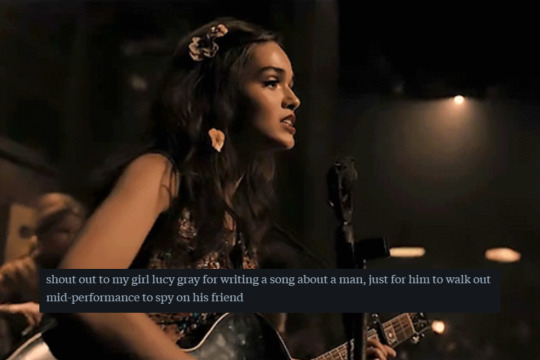

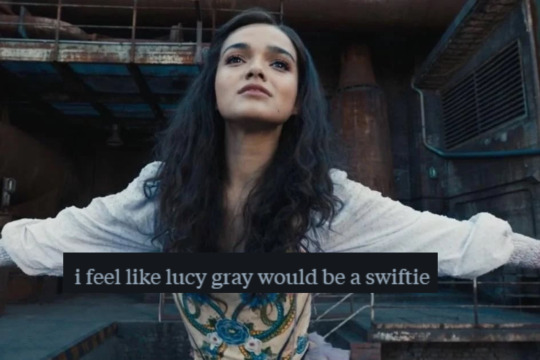
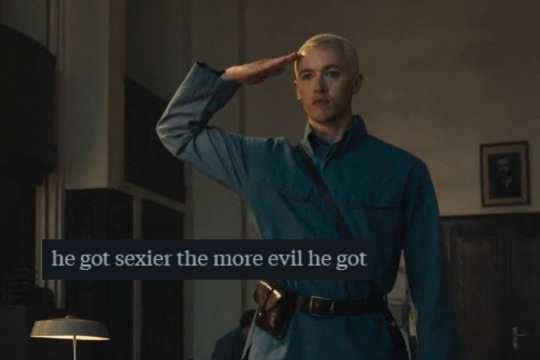
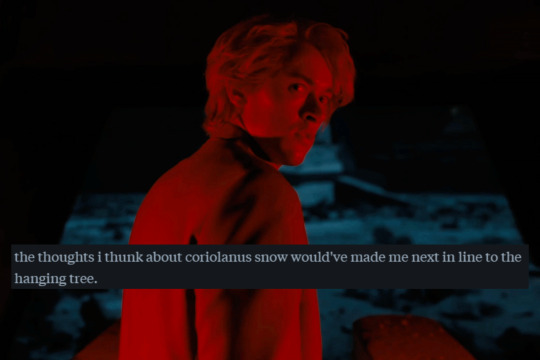
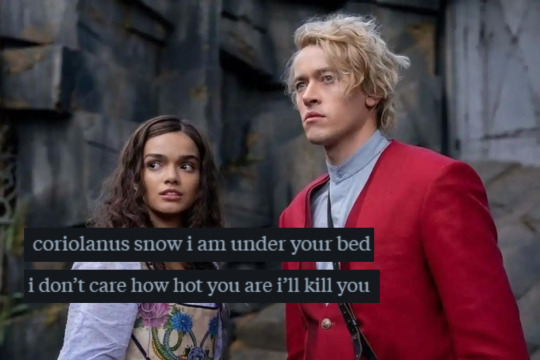
Pt 6
#the ballad of songbirds and snakes#the hunger games#THG#TBOSAS#BOSAS#coriolanus snow#lucy gray baird#Reviews#Funny Reviews#Funny#Ballad of songbirds and snakes
2K notes
·
View notes
Text
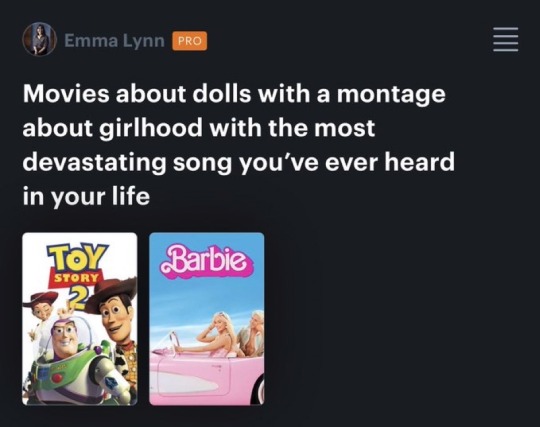
#letterboxd#movie#movie review#movie reviews#movies#movie recommendation#movie recommendations#review#reviews#barbie#greta gerwig#margot robbie#ryan gosling#toy story#toy story 2#barbie the movie#billie eilish
7K notes
·
View notes
Text

Saw this on my feed.
Something tells me that Saberspark is gonna focus on the spiteful hate instead of the actual legit criticism on the show's poor writing, as well as the other messed up stuff the creator said and did.
I'm worried that's gonna be the case.
#saberspark#hazbin critical#helluva boss#hazbin hotel#helluva boss critical#hazbin hotel critical#reviews
249 notes
·
View notes